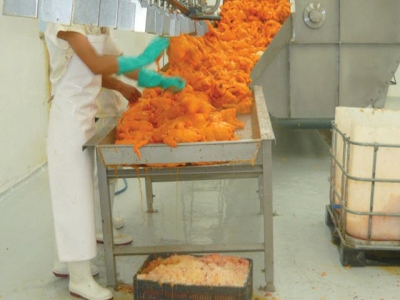How to ensure efficient processed chicken packing

A buildup of birds at the chiller exit needs to be avoided if the packing team is to have a regular supply of product. | Eduardo Cervantes López
For packing to run smoothly at the processing plant, prior operations need to be performed well and delays avoided.
To ensure efficient packing of chicken at the poultry processing plant, staff must have all the equipment they need and ergonomic workstations, but plant management needs to be conscious of the packing section’s needs as far back as chilling if delays and bottlenecks are not to occur, disrupting workflow.
Processing speeds tend to be fairly constant from the point of hanging live birds on the shackles through carcasses leaving the pre-chiller, and managers need to ensure that this flow is not subsequently lost.
Where air chilling is used, this speed tends to be maintained, but whether air chilling or water chilling is employed, it is from this point onwards that the needs of the packing section need be kept in mind, and backlogs of birds prevented.
Delays at this stage can not only disrupt packing operations, but also lead to yield reduction through water loss. Ensuring that speeds from this point on are the same as prior to chilling can prevent a variety of issues.
How issues may arise will vary depending upon whether a plant uses water or air chilling.
Issues at water chilling
Generally, once carcasses exit the chiller, they are placed onto special trays from which workers hang them on an aerial conveyor for dripping and, depending on the anatomical point of hanging, more or less water will be lost. In many plants, these conveyors will transport the carcasses to various points -- either for immediate packing or to the portioning area.
But should a plant’s infrastructure be poor, or management of these operations weak, delays may occur with a negative effect for packing.
For example, in some plants, once carcasses leave the chiller they enter a revolving cylinder to remove excess water. If the time spent in this cylinder is not carefully controlled, there will be an accumulation of birds inside it, leading to birds building up prior to entry.
But this is not the only issue that may arise. Given the interrupted flow after the drum and that birds of different weights will be sent in different directions, there may not be sufficient qualities of birds of a particular weight to send forward.
A solution employed in some plants to ensure that that the packing team is not left waiting has been to install a series of guides to ensure that each carcass keeps moving and reaches workers for hanging.
Issues with air chilling
Given that eviscerated carcasses are automatically transferred via the aerial conveyor, backlogs tend not to occur with air chilling, as speeds are the same as in previous operations.
However, once carcasses are removed from the overhead conveyor to be sent for packing or portioning and deboning, problems can occur, and it is not uncommon for large quantities of birds to build up.
Whole chickens are packed individually using systems that are automatically opened, and then sealed using a metal staples or plastic bands. Here too, bottlenecks may arise due to not all workers working at the same speed.
To remedy this, in many plants automatic baggers have been placed at the point where birds are taken off the overhead conveyors. This helps to maintain consistent workflow as the new task of the worker is simply closing the bagged chickens, while conveyor belts continue to circulate open bags, preventing them from building up.
Those carcasses that are not individually bagged are placed in bulk into cardboard or plastic boxes, and sent for weighing. In some cases, ice is added to keep them cold. These boxes are moved on conveyor belts or skate wheel transporters and then loaded onto pallets, where they are encased in film and then moved to cold stores using an electric forklift truck.
Portioning and deboning
Some carcasses are sent for portioning and deboning and, here too, there are may be issues that are due to the poor execution of tasks earlier in the process.
For example, where automatic portioning is employed, if feathers have been left on the carcass, or the cuticle not removed from the leg joint, bottlenecks may occur as time will be needed to address this.
The conveyor belt must be suitable for the work being carried out and the workers working along it. If not, workers will take longer to reach parts, place them in containers and return them to the belt. This again may result in product building up, which may lead to quality issues.
Where manual portioning occurs, the issues may arise with feathers and the leg cuticle, slowing the flow of work, and a failure to use ergonomic workstations will slow worker performance and efficiency.
Related news
 3 poultry technology solutions to harness big data
3 poultry technology solutions to harness big data Big data is the next big opportunity for poultry producers as the gap grows between the increasing amount and complexity of data available
 Disease challenges of cage-free egg production
Disease challenges of cage-free egg production Disease and emerging pathogens present cage-free egg producers with challenges that may require changes in operational practices.
 How free-range access impacts poultry health, welfare
How free-range access impacts poultry health, welfare Does free-range access really offer birds a better lifestyle? A recent report dove into the research surrounding the issue.